will wrought iron rust
The Enduring Legacy of Wrought Iron Understanding Its Strengths and Vulnerabilities
Wrought iron, a material that has been utilized for centuries, remains one of the most significant contributions to metalworking and engineering. Known for its malleability and strength, wrought iron has found its place in various applications, from architectural structures to decorative elements. However, one of the critical challenges associated with wrought iron is its susceptibility to rust, a phenomenon that can compromise its integrity and longevity. Understanding the nature of wrought iron, the process of rust formation, and methods to mitigate corrosion is essential for preserving this remarkable material.
Wrought Iron A Historical Overview
Wrought iron is an alloy of iron that has low carbon content, typically less than 0.08%. This unique composition gives wrought iron its distinctive properties, such as its ability to be easily manipulated when heated. Historically, wrought iron was crafted through a labor-intensive process that involved heating iron ore and hammering it to remove impurities. The ancient artisans were not only metallurgists but also artists, creating beautiful wrought iron railings, gates, and furniture that are still admired today.
Throughout history, wrought iron has played a vital role in various industries. During the Industrial Revolution, it became an essential material for building bridges, railways, and industrial machines due to its strength and ductility. However, as the demand for steel increased, the production of wrought iron declined, leading to a shift towards other materials. Nevertheless, wrought iron remains cherished for its unique aesthetic qualities and its ability to withstand stress without breaking.
Understanding Rust Formation
Rust is the common term for iron oxide, which forms when iron reacts with oxygen and moisture in the environment. This process is known as oxidation, which occurs when iron is exposed to humidity, water, or other corrosive elements over time. The chemical reaction can be simplified as follows
\[ \text{4Fe} + \text{3O}_2 + \text{6H}_2\text{O} \rightarrow \text{4Fe(OH)}_3 \]
Upon further exposure, iron(III) hydroxide dehydrates to form rust, which is a flaky, reddish-brown substance. Unfortunately, rust not only affects the appearance of wrought iron but also weakens its structural integrity. As rust forms, it expands and can flake off, compromising the material beneath and leading to further corrosion.
will wrought iron rust

Protecting Wrought Iron from Rust
To extend the life of wrought iron and preserve its functionality and aesthetics, several preventive measures can be implemented.
1. Protective Coatings One of the most effective ways to prevent rust is to apply protective coatings. Paints that contain rust-inhibiting compounds can create a barrier against moisture and oxygen. Galvanization, the process of coating iron with a layer of zinc, is another effective method. Zinc acts as a sacrificial anode, corroding in place of the iron underneath.
2. Regular Maintenance Routine inspections and maintenance can catch early signs of rust. Spotting and addressing small patches of oxidation before they become extensive can save significant time and resources. Cleaning the surface and reapplying protective coatings as necessary is crucial.
3. Environmental Control Since moisture is a key factor in rust formation, minimizing exposure to wet conditions can help. In environments where wrought iron is exposed to the elements, such as outdoor railings and gates, using stainless steel fasteners and minimizing contact with other materials that trap moisture can be beneficial.
4. Design Considerations Designing wrought iron components to allow for drainage and airflow can reduce the chances of water accumulation, thus mitigating rust formation.
Conclusion
Though wrought iron holds enormous historical and practical significance, its vulnerability to rust is a challenge that must be acknowledged and addressed. By understanding the fundamentals of wrought iron and the processes that lead to corrosion, we can take informed steps to protect and preserve this remarkable material. A commitment to maintenance and proactive care can ensure that wrought iron continues to be a material of choice in architecture and design, standing the test of time against the elements that threaten its existence.
-
Wrought Iron Components: Timeless Elegance and Structural StrengthNewsJul.28,2025
-
Window Hardware Essentials: Rollers, Handles, and Locking SolutionsNewsJul.28,2025
-
Small Agricultural Processing Machines: Corn Threshers, Cassava Chippers, Grain Peelers & Chaff CuttersNewsJul.28,2025
-
Sliding Rollers: Smooth, Silent, and Built to LastNewsJul.28,2025
-
Cast Iron Stoves: Timeless Heating with Modern EfficiencyNewsJul.28,2025
-
Cast Iron Pipe and Fitting: Durable, Fire-Resistant Solutions for Plumbing and DrainageNewsJul.28,2025
-
 Wrought Iron Components: Timeless Elegance and Structural StrengthJul-28-2025Wrought Iron Components: Timeless Elegance and Structural Strength
Wrought Iron Components: Timeless Elegance and Structural StrengthJul-28-2025Wrought Iron Components: Timeless Elegance and Structural Strength -
 Window Hardware Essentials: Rollers, Handles, and Locking SolutionsJul-28-2025Window Hardware Essentials: Rollers, Handles, and Locking Solutions
Window Hardware Essentials: Rollers, Handles, and Locking SolutionsJul-28-2025Window Hardware Essentials: Rollers, Handles, and Locking Solutions -
 Small Agricultural Processing Machines: Corn Threshers, Cassava Chippers, Grain Peelers & Chaff CuttersJul-28-2025Small Agricultural Processing Machines: Corn Threshers, Cassava Chippers, Grain Peelers & Chaff Cutters
Small Agricultural Processing Machines: Corn Threshers, Cassava Chippers, Grain Peelers & Chaff CuttersJul-28-2025Small Agricultural Processing Machines: Corn Threshers, Cassava Chippers, Grain Peelers & Chaff Cutters












